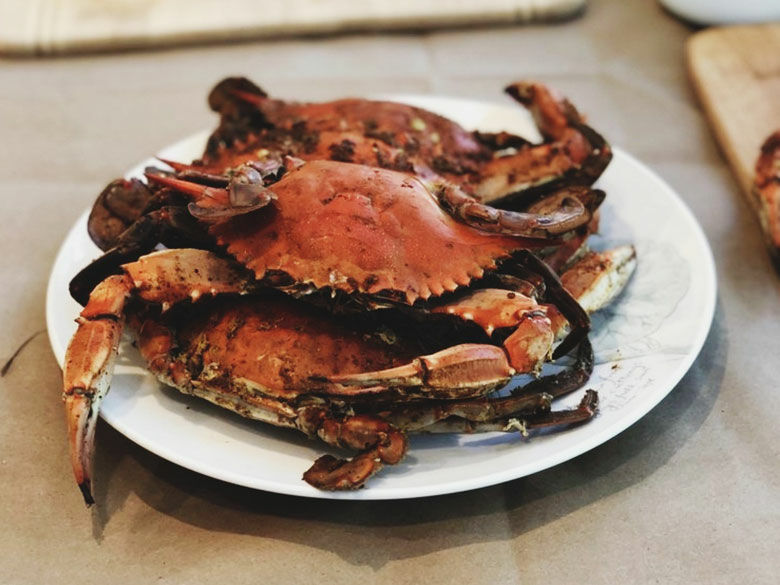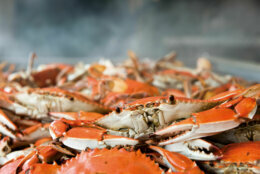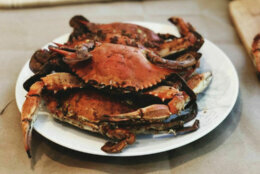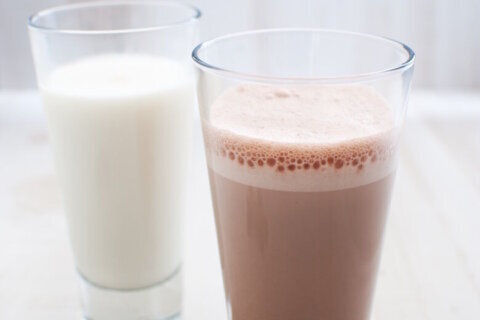



Wondering how you can get your traditional summertime seafood fix during the coronavirus pandemic if you’re not quite ready for that beach vacation or restaurant seafood tower?
How about ordering a few dozen oysters, plus a shucking kit, from a local pickle company? Or getting live crabs from the Market at Ivy City Smokehouse? Or even asking a North Bethesda, Maryland, sushi restaurant for a take-home seafood boil kit?
With a little pandemic-prompted ingenuity, you can make all your shellfish dreams come true on the back patio, in your home kitchen or even a local park with a grill.
Just because you can’t, or don’t, yet feel comfortable going to your favorite Chesapeake Bay-side restaurant or beach tavern this summer, that doesn’t mean you have to deprive yourself of your favorite seafood.
And with a number of typical seafood restaurants and raw bars seeing reduced traffic, some new players have gotten involved in the supply chain.
When Caitlin Roberts, the co-owner of Number 1 Sons, a pickled veggies vendor popular at a number of D.C.-area farmer’s markets, discovered that oyster farmers in Virginia were having trouble selling their bivalves to local bars and restaurants, she realized that her pickle company could help.
Roberts and her team went from selling items like honey habanero pickles, kosher dills and kimchi to a fervent fermented fan base from their farmer’s market tents at places like Dupont Circle and Eastern Market, to making deliveries of their briny veggies and other farm staples with their pickle van in the early days of the pandemic.
“We pivoted hard to home delivery,” Roberts said.
She realized her company had the infrastructure — an e-commerce website for socially distant market day preorders, for example — to help get oysters out to seafood fans. So she partnered with Rappahannock River Oysters, a family-run business in Topping, Virginia, along the coast due east of Richmond.
So, by late May, Roberts and her pickle brigade were selling about 1,000 oysters per week, along with shucking kits, to seafood fans in the region.
Even though there were a few early distribution hiccups — for example, one customer opened her oysters with a flat-head screwdriver when the shucking knife didn’t make it into the delivery — Roberts said adding oysters to pickles, while an unlikely combination, has paid off.
“People have said, ‘Oh, this is so exciting to learn a new skill at home, I never would have done this.’ We’ve gotten some beautiful pictures of people’s oyster dinners at home,” Roberts said.
Number 1 Sons is selling the ingredients so people can make their own vinegar-based mignonette sauce for the oysters. Turns out a pickle vendor’s supply chain syncs up well with oysters, after all.
The oysters are available via Number 1 Sons’ website, with three delivery windows per week. They come in a cooler with ice packs. Twenty-five oysters run $45.
Roberts said the oysters need to be kept in the fridge, and they don’t need to be eaten right away … they can stay fresh for a couple days, but it is better to eat them as soon as possible. At that point, they’re just about 24 hours removed from the river.
But how to prep oysters at home without losing a finger? That’s what YouTube is for, Roberts said. And Number 1 Sons has a video for that purpose.
But for beginners, a protective glove and shucking knife is an ideal, safe way to start. Then, scrub the oysters to remove any grit and get your platter with ice or rock salt ready.
Ron Goodman, the culinary director of Ivy City Smokehouse and Ivy City Tavern in Northeast D.C., said the next step is to start with the hinge, if you’re a novice.
“Keep the hand that doesn’t have the knife, away, so that if you’re going into the hinge, you’re not going to hit your hand,” Goodman said. “Don’t put a ton of force, just really wiggle it in there. There’s some really good videos. I’ve seen people tell me they’ve seen a video and they’ve learned and actually gotten pretty proficient at it.”
Before you shuck the oysters, be sure to keep them in the coldest part of your fridge — but make sure they don’t freeze, Roberts said. Arrange them so the cup side of the shell is down, so that it takes pressure off the muscle that holds the shell together.
Most people have success in their initial foray into shucking.
“I haven’t gotten any reports of anyone missing any fingers yet,” Roberts said with a laugh.
If you’re looking for seafood to take home, don’t forget to consider nontraditional sources. Most restaurants that serve fish, even sushi restaurants, can help you get the ingredients you want for your at-home seafood feast.
For example, if you’re in Montgomery County and don’t want to make the trek into D.C. to The Wharf, consider talking with Wesley Yao, one of the owners and general manager of Kusshi Sushi at the Pike and Rose complex in North Bethesda.
He’s been making take-home bundles of steamed crabs available for his customers who are used to visiting his restaurant for traditional sushi preparations.
“Since we used a lot of fresh fish,” Yao said, “getting seafood is easy for us.”
The concept of what he offers his customers came from what he did in past years for his employees, making a beer-steamed crab boil a few times each summer.
“A lot of people are doing a sushi with crabs combination,” he said. “Sushi rolls, or sashimi, or some fried appetizers like dumplings.”
If you want live crabs, he can get them for you, too.
Once you decide you want crabs, what do you do with them when you take them home, and how many crabs should you buy?
Our experts weighed in.
First, Yao said most of the time seafood vendors recommend a dozen crabs per person, but that’s probably too many.
“By the six, seventh, eighth one, you’re just tired of picking the crab, so I would recommend maybe four dozen for five people,” he said. Especially, he said, if you’re making corn on the cob or some other side dishes.
Then what?
Start with the broth. Yao likes a beer and apple cider vinegar mixture with Old Bay seasoning.
“You set up the pot, get the beer boiling. Get everything hot and going before you drop the crabs in,” he said. “We drop the crabs for 19 minutes. This becomes the biggest debate. A lot of people say 18, some say 20, some say 25, we do about 19.”
If you don’t have a crab steamer, another option is to use the vessel you may have used to fry a turkey outdoors during Thanksgiving. It’s basically the same setup.
Goodman, of Ivy City, said a little work in the backyard before it’s time to cook can pay off.
“There is a way you can rig up a steamer,” he said. “Go find a few rocks from your backyard and clean ‘em real well, put them in the bottom of the pot, then fill up the pot just to the level that you have the rocks, and then put a lid on that. Bring that to hard boil and put the crabs in there.”
His preferred liquid is: half water, one quarter beer, one quarter vinegar and crab spice. He’ll add black pepper to amp up the Old Bay.
Goodman recommends 12 to 20 minutes of steaming, depending on the size of the crab.
What about shopping for seafood these days? Before the coronavirus pandemic, you could literally go to a fish market and look a whole fish in the eye. Maybe you don’t want to do that anymore.
It certainly helps if you have a fishmonger you trust. Then, you can just order ahead for contactless pickup, Goodman said.
“Then, I don’t think you have anything to worry about. But for a whole fish, you want nice, clear eyes and a slippery slime, not a sticky slime, on the fish. Then, nice, red, gills and a clean smell.”
With clams and oysters, he said make sure “the shells are closed and they have a nice, clean, oceany smell.”
With a filet, look for a dark red, not brown, “blood line,” Goodman said.
At Ivy City’s restaurant and fish market, crabs are a popular item, and generally, people like to pick them up pre-steamed, especially if they live in an apartment and don’t want their bedroom to be permanently infused with the scent of Old Bay. Goodman said a steamed crab will keep for a few hours. You don’t have to rush home to eat them instantly.
The issue, though, is that one never knows how many crabs the fishermen will come in with, so it’s important to contact your preferred vendor a day or two ahead to make sure they’ll hold some of the crustaceans for you.
If you’re interested in more than just steamed crabs, Goodman had this idea:
Crab Bake (crab stuffed with crab meat)
- Steam the crab about 85%.
- Clean the lungs out.
- Stuff the cavity with a crab cake mixture.
- Cover the crab with seaweed — put it over the claws and legs.
- Bake until hot.
“It’s definitely a lot of work,” he said, “but it’s good for somebody who wants to take on a project.”
Finally, if you want a nearly-effortless backyard seafood feast, champion barbecue pitmaster Tuffy Stone, who has often competed with his Cool Smoke team at the Barbecue Battle on Pennsylvania Avenue in D.C., suggested a low-country boil.
For this, the main ingredient is shrimp, and it’s the last item to go into the pot.
“Sometimes shucking oysters can be a little intimidating, doing a crab boil can be a little intimidating too, cracking the shell can be a little bit of a pain,” Stone, who lives in Richmond, said.
“It’s just shrimp, a pot of water, cut up some lemons, some onions, add peppercorns and a seasoning packet like Old Bay,” Stone said.
This is where the turkey cooker that’s been taking up space since November comes in. Bring the water to a boil, add the seasoning, add potatoes and corn — items that will take the longest to cook go in first — then add the shrimp at the very end.
“It’s a great communal food, it’s a great dish to lay out for a gathering. It can be as small a quantity or as large a quantity as you want,” Stone said.
If everyone brings a side dish, all you, as the host, have to worry about is cooking the shrimp, he said.
“It might seem like it’s daunting, but really at the end of the day, it’s not that hard. … What’s so nice about that is the whole dish is pretty much cooked in one pot.”
- Sign up for WTOP alerts
- Silver Spring man feeds thousands of neighbors during the pandemic
- Maryland fines 4 nursing homes for lack of universal coronavirus testing
- Latest coronavirus test results in DC, Maryland and Virginia
- Coronavirus FAQ: What you need to know
- Coronavirus resources: Get and give help in DC, Maryland and Virginia
Looking for more information? D.C., Maryland and Virginia are each releasing more data every day. Visit their official sites here: Virginia | Maryland | D.C.








